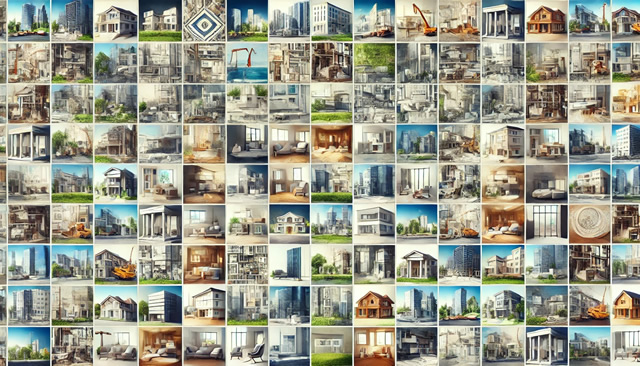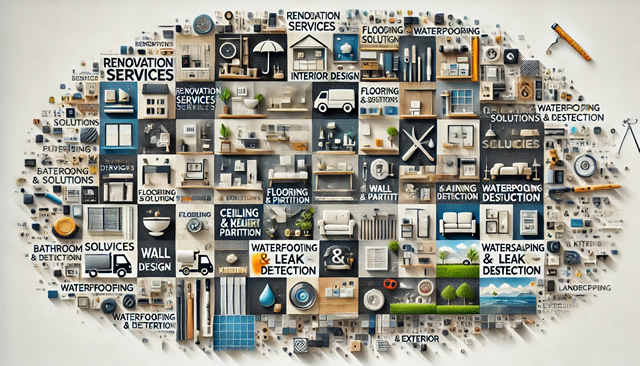Types of Commercial Renovations:
Office Renovation: Upgrading office spaces to enhance productivity and employee well-being. This can include creating open-plan layouts, improving lighting, and optimizing the use of space for collaboration.
Retail Store Renovation: Enhancing the shopping experience by updating store displays, changing layouts, and modernizing the interiors to attract customers and increase sales.
Restaurant and Hospitality Renovation: Renovations for restaurants, cafes, and hotels focus on creating inviting, comfortable, and stylish environments that attract guests and enhance their experience.
Public Sector Renovation: This includes renovations of government buildings, schools, libraries, and hospitals, focusing on functionality, accessibility, and compliance with regulations.
Why Choose Commercial Renovation?
A well-renovated commercial space not only boosts the productivity of employees but also creates a positive impression for customers and clients. Commercial renovations can lead to a more inviting and functional environment that enhances business operations and drives growth.
3. Industrial Property Renovation
Industrial renovations focus on optimizing the functionality, safety, and efficiency of industrial buildings such as factories, warehouses, and manufacturing facilities. These renovations often involve upgrading machinery, improving layout designs, and enhancing safety features.
Types of Industrial Renovations:
Warehouse Renovation: Upgrading storage systems, reorganizing layouts, and improving lighting and ventilation to create a more efficient space.
Factory & Manufacturing Facility Renovation: This can include upgrading machinery, enhancing the assembly line, improving safety protocols, and increasing overall efficiency within the facility.
Energy Efficiency Upgrades: Many industrial renovations include implementing energy-efficient systems, such as installing better insulation, energy-efficient lighting, or renewable energy solutions like solar panels.
Structural Reinforcements: Some industrial spaces require structural changes to support heavy machinery or to improve safety during operations.
Why Choose Industrial Renovation?
Industrial renovations are essential for maintaining safety standards, improving operational efficiency, and reducing energy costs. These upgrades also help in keeping up with industry standards and regulations, ensuring smooth operations and minimal downtime.
4. Exterior Renovation
Exterior renovation focuses on improving the outward appearance of a property while ensuring it is protected from the elements. Whether for residential, commercial, or industrial properties, the exterior plays a vital role in curb appeal, property value, and functionality.
Types of Exterior Renovations:
Roofing Renovation: Replacing or repairing roofing materials to improve weather resistance and energy efficiency.
Facade & Siding Renovation: Updating the exterior cladding, including painting, repairing, or replacing materials like brick, wood, or vinyl siding.
Landscaping & Garden Design: Creating or enhancing outdoor spaces through gardening, landscaping, and the installation of outdoor features like patios, fences, and walkways.
Windows & Doors Installation: Installing energy-efficient windows and doors that improve insulation and security while enhancing the appearance of the property.
Why Choose Exterior Renovation?
Exterior renovations enhance the overall look of your property, increase its value, and improve its energy efficiency. They also protect the structure from weather-related damage, ensuring long-term durability and reducing maintenance costs.
5. Eco-Friendly Renovations
As sustainability becomes a growing concern, eco-friendly renovations focus on making properties more energy-efficient and environmentally friendly. These renovations aim to reduce energy consumption, minimize waste, and improve overall environmental impact.
Types of Eco-Friendly Renovations:
Energy-Efficient Upgrades: Installing energy-efficient windows, insulation, lighting, and appliances to reduce energy consumption.
Solar Panel Installation: Adding solar panels to generate renewable energy and reduce reliance on traditional energy sources.
Water Conservation Measures: Installing low-flow fixtures, water-saving irrigation systems, and rainwater harvesting systems to reduce water consumption.
Sustainable Materials: Using sustainable, recycled, or locally sourced materials for renovations to minimize environmental impact.
Why Choose Eco-Friendly Renovation?
Eco-friendly renovations help reduce the carbon footprint of your property, lower utility bills, and contribute to a more sustainable future. These renovations can also improve indoor air quality and create healthier living environments.
Conclusion
Renovating your property is an excellent way to enhance its value, functionality, and aesthetic appeal. Whether you’re renovating your home, office, or industrial space, it’s important to understand the different types of renovations and choose the right one for your needs. By considering your goals and working with experienced professionals, you can ensure that your renovation project not only meets your expectations but also improves the overall quality and value of your property.









